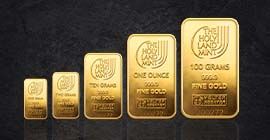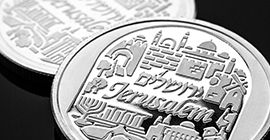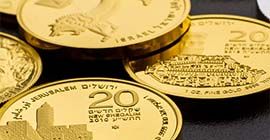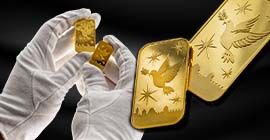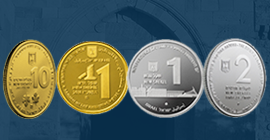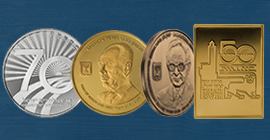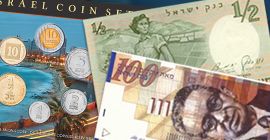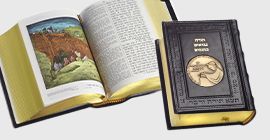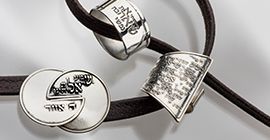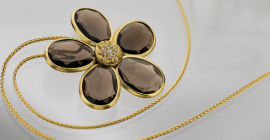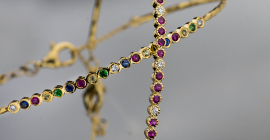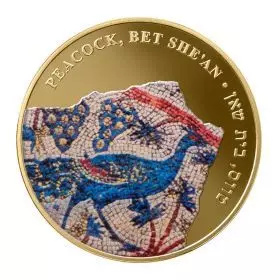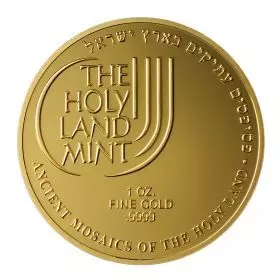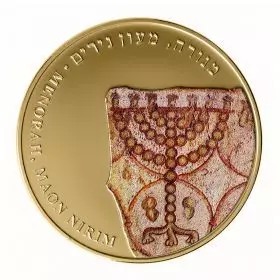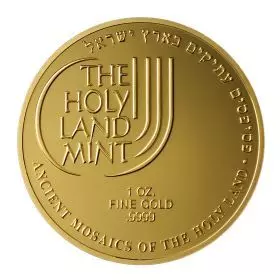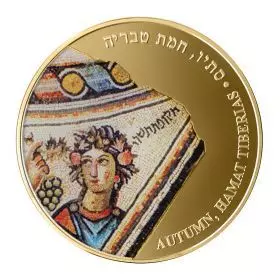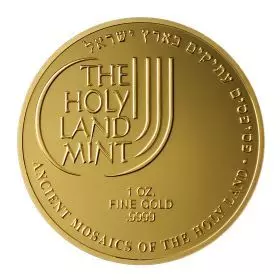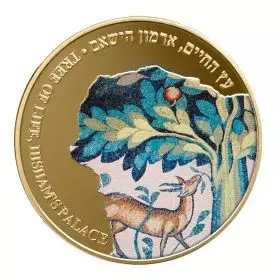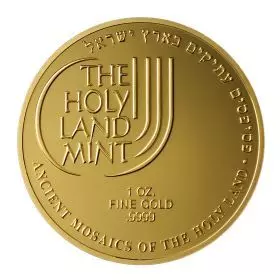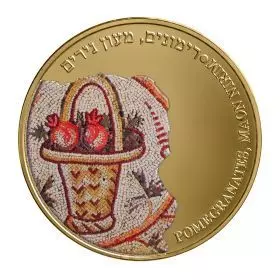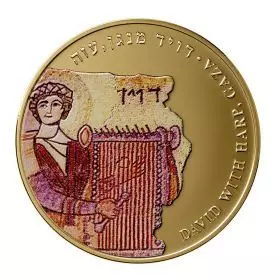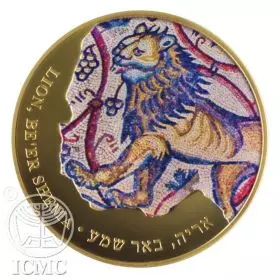Fishes
Gold 9999, 38.7 mm, 1 oz.
SKU
31874390
Out of stock
$6,160.00
Notify when back in stock
You will be notified via email when this product is back in stock. The current price represents the current sale price of the item, however the company cannot guarantee this sale price once back in stock.
Specifications
| Issuing Year | 2013 |
|---|---|
| Material | Gold |
| Fineness | 9999 |
| Weight | 1 oz. |
| Diameter | 38.7 mm |
| Max Mintage | 360 |
| Design | Meir Eshel |
"FISHES" MOSAIC FROM BEIT SHE'AN
7TH MEDAL IN THE "ANCIENT MOSAICS IN THE HOLY LAND" SERIES
Beit She'an is one of the oldest cities in the Land of Israel. Its importance lay in its strategic situation at the crossroads of the routes from west to east (from the Mediterranean coast in the west, through the Zebulun and Jezreel Valleys, across the Jordan in the east) and north to south (the Jordan Valley). The fertile lands of the valleys and the abundance of springs in the region provided an economic advantage for Bet She'an. (The Beit She'an Valley is known today in Israel as the "Valley of Springs" and fish farming is one of the thriving industries in the Valley). Archeological research has proved that in ancient times, the city was located on a hill known as the Tel (hill of) Beit She'an, which overlooked the surrounding area.
Beit She'an was part of the territory of the Tribe of Menasseh but because of the military power of the Canaanites of the region, the Tribe of Menasseh was not successful in taking possession of the city. In the time of King Solomon, Beit She'an was located in one of the administrative regions responsible for the valley area. "Solomon had twelve officers over all Israel…", one of whom was Ba'ana, who controlled "Ta'anakh and Megiddo and all of Beit She'an…(Kings I, 7).
From the Hellenistic period, the urban area of Beit She'an grew beyond the original hill. In Roman times, the City became a regional center and its name became Scythopolis. During the Byzantine period, Beit She'an reached the height of its growth and prosperity, developing outwards, around the original hill, in all directions. Its northern part was crossed by the Harod River. During this period, the City was enclosed by a wall, of which remains have been found in different places. In archeological excavations, many structures dating from the Byzantine period have been discovered, attesting to a prosperous economy. The character of the city at the time was mainly Christian, like that of the other settlements that gradually came under the influence of the prevailing Byzantine culture. Nevertheless, there were also Jewish and Samaritan communities in the City.
Despite the contributions to culture that came with the change from Roman to Byzantine rule, Byzantine culture adopted many Roman characteristics and, among them, the Bath. The Bath was not only used for cleanliness purposes, but also for relaxation and health purposes in general. Bathers would often spend many hours at the Bath and take advantage of the time for their social meetings, as well as political and philosophical discussions. In view of the special social and cultural role of the Bath in Roman and Byzantine times, many resources were invested in the technical aspects, such as the provision of running hot water and adornments for the building, including artistic sculpted stone, colorful drawings on the walls and impressive mosaics.
The Bath in Beit She'an was discovered in the center of the Byzantine City, north-west of the theater. The building stretched over an area of about 7 dunam (1,000 sq. m, approx. 1,200 sq. yds), the largest such area in the Land of Israel, and was a splendid edifice. Its floors were covered in marble with varied mosaics. A fragment of one of these mosaics is featured on this medal, the central motif of the mosaic being three fishes and a plant decoration.
Fishes appear frequently on mosaic art from the Byzantine period and several such mosaics have been uncovered in the Land of Israel. This can be explained by the symbolism associated with fish in this period. In Christianity, Jesus is said to have performed miracles through fish: the "miracle of the 5 loaves and 2 fish" (when 5,000 people were fed with 5 loaves of bread and 2 fishes) and the miraculous catch of fish by his disciples, under his instructions.
In Judaism, fish are a symbol of blessing and plenty. When the Patriarch Jacob blessed Ephraim and Menasseh, the two sons of Joseph, that they should multiply, he used the Hebrew verb stemming from the word "fish"; Fish are a symbol of plenty, found in the seas and rivers, away from the evil eye, and they are a good sign, because solely, fish were not punished by destruction from the waters of the flood.
According to Rabbi Yossi, son of Rabbi Hanina, (teachers of the Oral Law at the end of the 3rd century), fish are a symbol of blessing and stability because of their unique environment; Covered by the waters, the evil eye cannot control them (Babylonian Talmud, Berachot Tractate). His words may have been an allusion to the way in which he thought the Jewish community should conduct itself in face of its enemies that rise against them in every generation, whether Pagans, Romans, Byzantine or other: one should not fear, not make oneself prominent, maintain a distance and avoid contact.
Fish are a sign of blessing and, by virtue of their silence and conduct in many ways, are a good example for man!
Photography of the Mosaic: Courtesy, the Israel Antiquities Authority
Edge: Smooth with serial number.
Designer: Meir Eshel.
Engraving: USA
Mint: USA
Issue Name: Ancient Mosaics, Fishes
Series Name: Holy Land Ancient Mosaics
| Catalog SKU | Condition | Diameter | Issue Price | Issuing Year | Material | Quantity | Weight |
|---|---|---|---|---|---|---|---|
| 31874390 | 38.7 mm | Unavailable Info | 2013 | Gold 9999 | 360 | 1 oz. | |
| 21874390 | 38.7 mm | 549 NIS | 2012 | Silver/999 | 888 | 1oz |

